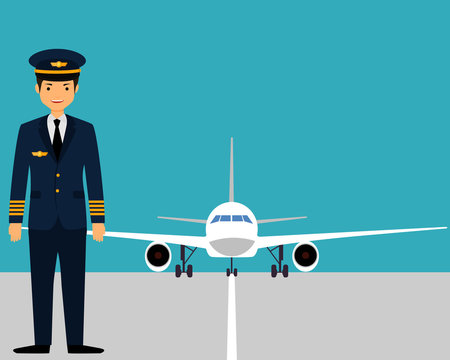Managing In-Flight Emergencies as a Pilot
Every pilot must be ready for the possibility of an in-flight emergency. While rare, these situations do occur, with medical emergencies happening in approximately 1 in every 604 flights. Other potential emergencies include system failures, adverse weather conditions, and security threats. By undergoing proper training and adhering to established protocols, pilots can confidently and effectively manage any in-flight emergency, whether or not an emergency landing is required.
 Types of In-Flight Emergencies
Types of In-Flight Emergencies
In-flight emergencies can arise for various reasons, each demanding a specific response and strict adherence to protocols. Through flight school and experience, pilots develop the skills to manage medical emergencies, system failures, adverse weather, and security threats. In every situation, they are trained to stay composed and focused, ensuring the safety of all passengers and crew on board.
Medical Issues
Emergency medical issues on flights are unpredictable. Some require urgent situations, including heart attacks or illness. Onboard medical equipment is critical to handling certain instances. This includes oxygen tanks and defibrillators. Pilots are required to work closely with their cabin crew, as well as medical personnel either onboard or on the ground.
Pilots need to make quick assessments to determine whether an emergency landing is needed. In those situations, pilots divert to a nearby airport for ground medical assistance. In these cases, they communicate with air traffic control to request assistance and flight diversion. This decision is based both on the severity of the emergency and the available medical facilities at nearby airports.
System Failures
Extensive flight training equips students with the skills to handle system failures effectively before earning their pilot certification. The most common system failures that pilots are trained to handle are:
- Engine failures
- Electrical failures
- Hydraulic system failures
- Flight control malfunctions
- Landing gear issues
- Fuel system failures
- Cabin pressurization failures
- Communication failures
- Instrument and navigation failures
- Brake system failures
- Wing and tail damage
- Ice or windshield failures
Flight school courses provide comprehensive training on system failures, preparing pilots to respond effectively when issues arise in the air. The FAA’s Standard Operating Procedures (SOPs) outline the necessary actions for handling various system failures, ensuring a structured and efficient response in critical situations. By combining flight training, experience, and adherence to SOPs, pilots prioritize the safety of all crew members and passengers.
Weather Emergencies
In the event of bad weather, most passengers will experience a flight delay or cancellation before getting on the plane. Storms, rain, fog, snow, heavy winds, and ice are all types of weather factors that are assessed before a flight. Pilots receive detailed weather briefings before flights that include the current conditions as well as forecasted conditions along their flight route.
If weather conditions require in-flight decision-making, pilots have the training and experience to adjust their route and identify alternate airports for potential diversion. They can make real-time adjustments to navigate around severe weather, such as thunderstorms, to minimize turbulence and ensure a safe flight.
Pilots maintain constant communication with Air Traffic Control (ATC) regarding changing weather along the flight route and weather deviations. Pilot Reports (PIREPs) are shared with ATC that share real-time weather observations, helping other pilots who may have to experience those conditions.
Security Threats
In-flight security risks are extremely rare. Regardless, security threats are another thing that pilots undergo extensive training to handle before ever taking flight. Pilots adhere to strict protocols on how to handle in-flight security risks, including unruly passengers, threats, cybersecurity anomalies, and hijacking. For example, in the event of hijacking, pilots adhere to the FAA Order JO 7610.4, which detailed procedures and reporting requirements under the Procedures for Handling Suspicious Flight Situations and Hijacked Aircraft.
In some cases, air marshals on board can help pilots intervene with potential theaters during flight. If a situation becomes critical, pilots will land at the nearest airport. With any security situation, law enforcement helps handle the situation once on the ground.
Standard Operating Procedures
Standard Operating Procedures (SOPs) are a set of guidelines that pilots follow, specifying how to safely fly a plane during any situation. Pilots are highly trained to manage potential situations before ever leaving the ground. Before graduating from flight school, students undergo extensive training to understand and respond to a wide range of in-flight emergencies. While most are uncommon, pilots are always trained to handle emergencies and make quick decisions for the safety of everyone on board.
The SOPs ensure safe aviation practices are followed through the use of checklists, crew coordination, consistent compliance with all SOPs, and a primary focus on safety.
Communicating with Air Traffic Control
Airline pilots use Very High Frequency (VHF) radios that operate at a frequency between 118 MHz to 136 MHz for short to medium-range communication with air traffic control. Long-distance communication requires use of High Frequency (HF) radios, which allow for global communication using a frequency between 3 MHz to 30 MHz. If a pilot loses contact through their frequency, they can switch to an international emergency frequency.
Flight courses teach students how to communicate using common aviation phrases, as well as clear and concise communication, before getting their certifications to become a pilot. Every pilot must learn how to effectively communicate with ATC. Even before a flight takes off, pilots are in communication with ATC.
In-flight emergencies require pilots to relay critical information to air traffic controllers. When radio becomes unavailable, pilots use transponder squawk codes, which are four-digit codes that identify a plane’s emergency to ATC, allowing them to coordinate assistance.
Emergency Landings and Diversions
Before making an emergency landing or diverting to the nearest airport, pilots are in communication with ATC to help them understand what type of emergency they are dealing with. Pilots report on number of passengers, type of emergency, aircraft type, and even fuel status. When the emergency is confirmed, ATC helps to find the best available airport.
Pilots then ensure that their crew, and, in turn, their passengers, are prepared for landing. In some emergency landing cases, pilots will need to use up excess fuel before landing as an added safety precaution. Proper emergency services are on standby on the ground for when the plane lands.
The Role of Training
Every potential emergency situation encountered during flight is thoroughly covered in flight school, ensuring pilots are well-prepared to handle them effectively. Before getting a license to become a pilot, every student must learn protocols and procedures that deal with in-flight emergencies, including security threats, weather changes, system failures, and medical emergencies. No student can graduate from flight school without understanding how to prepare for these situations.
FAA approved flight schools offer extensive training to handle critical moments that pilots may face in the air. Rigorous training ensures that pilots stay calm, assess threats, and act decisively during flight, safeguarding all passengers and crew.




